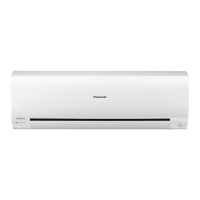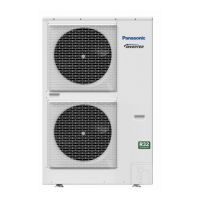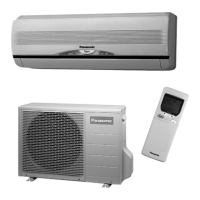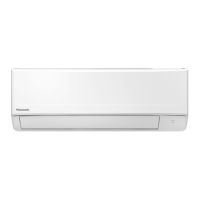22
2-17
RECOVERY
CAUTION
● When removing refrigerant from a system, either for servicing or decommissioning, it is recommended good practice that all
refrigerants are removed safely.
● When transferring refrigerant into cylinders, ensure that only appropriate refrigerant recovery cylinders are employed.
● Ensure that the correct number of cylinders for holding the total system charge are available.
● All cylinders to be used are designated for the recovered refrigerant and labelled for that refrigerant (i.e. special cylinders for the
recovery of refrigerant).
● Cylinders shall be complete with pressure-relief valve and associated shut-off valves in good working order.
● Empty recovery cylinders are evacuated and, if possible, cooled before recovery occurs.
● The recovery equipment shall be in good working order with a set of instructions concerning the equipment that is at hand and
shall be suitable for the recovery of all appropriate refrigerants including, when applicable, flammable refrigerants.
● In addition, a set of calibrated weighing scales shall be available and in good working order.
● Hoses shall be complete with leak-free disconnect couplings and in good condition.
● Before using the recovery machine, check that it is in satisfactory working order, has been properly maintained and that any
associated electrical components are sealed to prevent ignition in the event of a refrigerant release.
Consult manufacturer if in doubt.
● The recovered refrigerant shall be returned to the refrigerant supplier in the correct recovery cylinder, and the relevant waste
transfer note arranged.
● Do not mix refrigerants in recovery units and especially not in cylinders.
● If compressors or compressor oils are to be removed, ensure that they have been evacuated to an acceptable level to make
certain that flammable refrigerant does not remain within the lubricant.
● The evacuation process shall be carried out prior to returning the compressor to the suppliers.
● Only electric heating to the compressor body shall be employed to accelerate this process.
● When oil is drained from a system, it shall be carried out safely.
01_301769_2WAY_eng.indb 43 2018/3/20 9:15:17
2-14. PRECAUTIONS REGARDING TEST RUN
U-100PZ2R5, U-125PZ2R5, U-140PZ2R5
U-100PZ2R8, U-125PZ2R8, U-140PZ2R8
Check Before Test Run
Content check
Power supply cable
Indoor/outdoor connection wire
Earth wire
Is the wire set up and connected as described in the instructions? Check for any phase sequence.
Are the wire connection’s screws loose?
Is the open and close device / leakage breaker installed?
Is the power supply cable’s thickness and length appropriately measured as described in the instructions?
Is it earthed (grounded)?
Check that the insulation resistant value is more than 100M
.
Use the 500 V mega-testers to measure the insulation.
Do not use the mega-tester for any other circuit except for voltage of 230-240V~ or 400-415V 3N~.
Are the wire connections for the indoor/outdoor units connected as described in the instructions? Are there any looped wires?
Was the “N-phase” surely connected when connecting the power supply wire on the three-phase model?
If N-phase is not connected, only the fan may repeat turning ON/OFF without the compressor operating. In that case, check if there is any
problem with N-phase connection.
Refrigerant pipe
Is the piping installed as described in the instructions?
Are the pipes sizes appropriate?
Does the pipe’s length adhere to the specifi cations?
Is the branch pipe slant being appropriately done as described in the instructions?
Was vacuum removal suffi ciently carried out?
Was the leak tightness test carried out with nitrogen gas? Use the testing pressure of 4.15 MPa.
Is the piping insulation material appropriately installed? (Insulation material is necessary for both gas and liquid piping.)
Is the 3-way valve for the liquid side and gas side open?
Always be sure to use a properly insulated tool to operate the short-circuit pin on the circuit board. (Do not use your fi nger.)
Never switch the power supply ON until the installation has completed.
Supply electrical current through all indoor units and check the voltage.
Supply electrical current through all the outdoor units and check each inter-phase voltage.
Before the test run, ensure to check that the 3-way valve is open. Operating while the valve is closed causes the compressor to fail.
Test Run Procedure
If there are duplicated system addresses, or if the settings for the Nos.
of the indoor units are not consistent, an alarm will occur and the system
will not start.
Switch the power supply ON both indoor and outdoor unit.
Short-circuit CHK pin on the outdoor main PCB.
Do not remove CHK pin until test run is completed.
Removing CHK pin stops test run.
Short-circuit RUN pin on the outdoor main PCB for one second or longer.
Factory setting is cooling operation mode and cooling operation test run
starts.
If heating operation starts, short-circuit both right side and centre of the
MODE pin (centre and COOL) continuously.
Ensure to conduct a test run. In addition, be sure to run the cooling
operation test run for at least 20 minutes before starting the heating
operation test run.
To conduct heating operation test run, short-circuit left side and centre
of the MODE pin (centre and HEAT) continuously.
Removing CHK pin’s and MODE pin's short-circuit stops test run.
For the test run using remote control unit, please see installation
instructions included with the remote control unit.
*MODE pin:
factory setting is
cooling operation
mode.
*MODE pin:
factory setting is
cooling operation
mode.
Caution for Pump Down
Pump down means refrigerant gas in the system is returned to the outdoor
unit. Pump down is used when the unit is to be moved, or before servicing the
refrigerant circuit.
How to perform Pump-Down (Refrigerant recovery) properly
1 Stop operation of the unit (cooling, heating etc.).
2 Connect the pressure gauge to the service port of the gas wiring valve.
3 Short-circuit the
Γ
PUMPDOWN
˩
pin on an outdoor unit control PCB (CR)
for more than 1 second to release.
Pump-Down begins and the unit starts operating.
During Pump-Down, LED1 blinks and LED2 is lit on an outdoor unit
control PCB (CR).
Γ
CHK
˩
blinks on the remote controller.
4 Fully close the liquid wiring valve 2-3 minutes later.
The Pump-Down will begin.
5 When the pressure gauge drops to 0.1-0.2MPa, close the gas wiring
valve tightly and short-circuit the
Γ
PUMPDOWN
˩
pin for more than 1
second to release. That is the end of Pump-Down.
When running for more than 10 minutes, it stops even if the Pump-
Down is not completed. Check the blocked state of the liquid side valve.
lt also stops when the
Γ
PUMPDOWN
˩
pin is short-circuited during the
operation.
For compressor protection, do not operate to the point where the unit wiring
side reaches negative pressure.
*
Note : In the case that inter-unit wiring is 30m or longer, you cannot pump-down.
(lt may trigger the operation of the overload protection device.)
In this case, perform pump-down with pump-down device.
PUMPDOWN
CHK
TEST
MODE
ON
A. ADD
STOP
RUN
LED1
LED2
R.C. ADD
SW1
SW2
LED1
LED2
SW1
SW2
ON
R.C. ADD
A. ADD
CHK
STOP
TEST
RUN
MODE
PUMPDOWN
LED1
LED2
LED1
LED2
Outdoor Unit Control PCB (CR)
1 phase model
Outdoor Unit Control PCB (CR)
3 phase model
SM830266-00_大洋州向けR32シングルTD&SM.indb 17 18/03/29 11:58:32
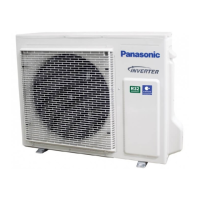
